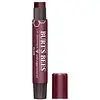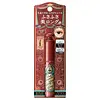What's inside
What's inside
 Key Ingredients
Key Ingredients

 Benefits
Benefits

 Concerns
Concerns

 Ingredients Side-by-side
Ingredients Side-by-side

Ricinus Communis Seed Oil
MaskingHelianthus Annuus Seed Oil
EmollientBeeswax
Emulsion StabilisingEuphorbia Cerifera Wax
Mentha Piperita Oil
MaskingLanolin
EmollientTheobroma Cacao Seed Butter
EmollientCopernicia Cerifera Wax
Butyrospermum Parkii Butter
Skin ConditioningFragaria Ananassa Seed Oil
AntioxidantPrunus Armeniaca Kernel Oil
MaskingRibes Nigrum Seed Oil
EmollientRosmarinus Officinalis Leaf Extract
AntimicrobialSambucus Nigra Seed Oil
Tocopherol
AntioxidantCanola Oil
EmollientGlycine Soja Oil
EmollientTin Oxide
AbrasiveMica
Cosmetic ColorantIron Oxides
CI 75470
Cosmetic ColorantAlumina
AbrasiveTitanium Dioxide
Cosmetic ColorantRicinus Communis Seed Oil, Helianthus Annuus Seed Oil, Beeswax, Euphorbia Cerifera Wax, Mentha Piperita Oil, Lanolin, Theobroma Cacao Seed Butter, Copernicia Cerifera Wax, Butyrospermum Parkii Butter, Fragaria Ananassa Seed Oil, Prunus Armeniaca Kernel Oil, Ribes Nigrum Seed Oil, Rosmarinus Officinalis Leaf Extract, Sambucus Nigra Seed Oil, Tocopherol, Canola Oil, Glycine Soja Oil, Tin Oxide, Mica, Iron Oxides, CI 75470, Alumina, Titanium Dioxide
Hydrogenated Polyisobutene
EmollientIsododecane
EmollientSucrose Tetrastearate Triacetate
EmollientDextrin Palmitate
EmulsifyingDisteardimonium Hectorite
StabilisingTrimethylsiloxysilylcarbamoyl Pullulan
PEG-10 Dimethicone
Skin ConditioningNylon-6
Butylene Glycol
HumectantWater
Skin ConditioningPEG-20 Hydrogenated Castor Oil Triisostearate
EmulsifyingTocopheryl Acetate
AntioxidantMacadamia Ternifolia Seed Oil
EmollientZinc Oxide
Cosmetic ColorantTriethoxycaprylylsilane
Tocopherol
AntioxidantBHT
AntioxidantTetramethylcyclotetrasiloxane
Silica
AbrasiveTetradecene
EmollientAluminum Hydroxide
EmollientSucrose Tetraisostearate
EmollientParaffin
PerfumingMicrocrystalline Wax
Emulsion StabilisingCI 77492
Cosmetic ColorantTitanium Dioxide
Cosmetic ColorantCI 77266
Cosmetic ColorantHydrogenated Polyisobutene, Isododecane, Sucrose Tetrastearate Triacetate, Dextrin Palmitate, Disteardimonium Hectorite, Trimethylsiloxysilylcarbamoyl Pullulan, PEG-10 Dimethicone, Nylon-6, Butylene Glycol, Water, PEG-20 Hydrogenated Castor Oil Triisostearate, Tocopheryl Acetate, Macadamia Ternifolia Seed Oil, Zinc Oxide, Triethoxycaprylylsilane, Tocopherol, BHT, Tetramethylcyclotetrasiloxane, Silica, Tetradecene, Aluminum Hydroxide, Sucrose Tetraisostearate, Paraffin, Microcrystalline Wax, CI 77492, Titanium Dioxide, CI 77266
Ingredients Explained
These ingredients are found in both products.
Ingredients higher up in an ingredient list are typically present in a larger amount.
Titanium dioxide is a mineral UV filter widely used in sunscreens and cosmetics.
It is one of only two UV filters officially classified as “mineral” by regulatory agencies, the other being zinc oxide.
Titanium dioxide provides broad-spectrum protection mostly in the UVB and UVAII range, with some protection in the UVAI range.
While its UVA protection isn’t as strong as zinc oxide’s, the difference is minor.
A common myth is that mineral UV filters reflect UV light. However, modern research shows titanium dioxide absorbs UV radiation like chemical filters (~95% absorption & 5% reflection).
Thanks to its non-irritating nature, titanium dioxide is suitable for sensitive, acne-prone, or redness-prone skin. It is unlikely to cause "eye sting" like other sunscreen ingredients.
A major drawback of this ingredient is its white cast and thick texture. This is why mineral sunscreens often leave a white cast and are less cosmetically elegant than chemical/hybrid sunscreens.
To improve white cast and spreadability, micronized or nano-sized titanium dioxide is often used.
There are ongoing concerns surrounding nano-titanium oxide's impact on marine ecosystems.
There is no conclusive evidence that any form of titanium oxide (or any other sunscreen ingredients) will cause harm to marine ecosystems or coral reefs. The science is still developing but many consumers are keeping a close eye on this issue.
Please note, many destinations have reef-safety sunscreen rules. For instance, the U.S. Virgin Islands advises all visitors to use non-nano mineral sunscreens.
Nano mineral sunscreens once raised safety concerns about absorption into skin.
Extensive research has shown that they do not penetrate healthy or damaged skin; they remain safely on the surface and the top layer of dead skin (stratum corneum).
You'll likely find titanium dioxide bundled with alumina, silica, or dimethicone. These ingredients help make titanium dioxide highly photostable; this prevents it from interacting with other formula components under UV light.
Learn more about Titanium DioxideTocopherol (also known as Vitamin E) is a common antioxidant used to help protect the skin from free-radicals and strengthen the skin barrier. It's also fat soluble - this means our skin is great at absorbing it.
Vitamin E also helps keep your natural skin lipids healthy. Your lipid skin barrier naturally consists of lipids, ceramides, and fatty acids. Vitamin E offers extra protection for your skin’s lipid barrier, keeping your skin healthy and nourished.
Another benefit is a bit of UV protection. Vitamin E helps reduce the damage caused by UVB rays. (It should not replace your sunscreen). Combining it with Vitamin C can decrease sunburned cells and hyperpigmentation after UV exposure.
You might have noticed Vitamin E + C often paired together. This is because it is great at stabilizing Vitamin C. Using the two together helps increase the effectiveness of both ingredients.
There are often claims that Vitamin E can reduce/prevent scarring, but these claims haven't been confirmed by scientific research.
Learn more about Tocopherol